
CONTENTS
OCEAN AND MARINE LIFE
- THE ARCTIC OCEAN AND THE OCEAN CURRENTS
- GENESIS OF THE ARCTIC OCEAN
- ARCTIC PLANKTON
- MARINE BIODIVERSITY AND FOOD WEB
- WHALES AND OTHER CETACEANS
- SEALS AND WALRUSES
TERRESTRIAL LIFE
- POLAR FLORA
- POLAR FAUNA
- THE POLAR BEAR
- ARCTIC BIRDS
- SPECIES EVOLUTION AND CLIMATE
HISTORY AND GEOGRAPHY
- GEOGRAPHY OF THE ARCTIC REGIONS
- GEOGRAPHIC NORTH POLE, MAGNETIC NORTH POLE
- WHO OWNS THE ARCTIC?
- THE EXPLORERS OF THE FAR NORTH
- THE INUIT
- OTHER PEOPLES OF THE FAR NORTH
- THE ARCTIC TODAY
POLAR SCAVOTTES AND GLACIERS: FRESHWATER TRAPS
Any snow that does not melt in summer accumulates, to be packed down, layer after layer, over the years and thus transformed into ice. Most of this ice will not become part of the sea once again for a very long time. This is how the huge thick ice caps form on top of polar landmasses such as Greenland and the continent of Antarctica.
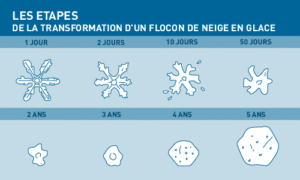
RIVERS OF ICE
A glacier is a sort of frozen river clinging onto a mountainside. The weight of the enormous mass of ice causes it to slide slowly downhill, gouging its own valley ever deeper. Glaciers are so slow that their movement is imperceptible to the human eye, but they are powerful enough to wrench chunks of rock from the bed of the valley as they pass. These rocks, ground into a mass of smaller stones called moraine, are deposited along the way or left at the foot of the glacier when it melts in summer.
ICEBERGS: FROZEN FRESH WATER RETURNS TO THE SEA
When the foot of a glacier happens to be on the coast, the tongue of ice is forced out onto sea, starts to float and then breaks off into chunks of ice called icebergs that are carried away to sea. When this happens, a glacier is said to be calving.
The icebergs, which are sometimes trapped in the pack ice, may also have quantities of moraine fused into their underside, and as the iceberg gradually melts these will fall to the seabed.
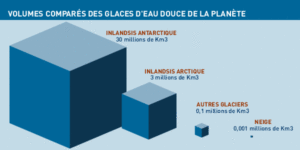
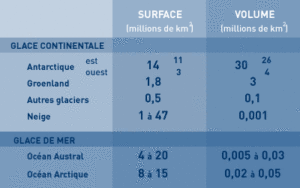
ICE CAPS CAN WEIGH CONTINENTS DOWN
During the Quaternary period, thick heavy ice caps covered much of northern Europe and North America. The weight of the ice caps bore the continents down and they sank lower into the fluid mantle of the Earth, rather like a ship when it is being loaded. Today, freed of their load, these continents are very slowly rising up again.
“INLANDSIS” THICK ICE CAPS ON TOP OF CONTINENTS
The Earth boasts two ice caps, or “inlandsis” (“inland ice” in Icelandic) today. In the Southern Hemisphere an enormous ice cap covers the 14-million-km2 continent (in reality an archipelago) of Antarctica, and in the Northern Hemisphere Greenland’s landmass is hidden under 1.8 million km2 of continental ice.
The Greenland ice cap, anchored between two coastal mountain chains, has a central basin where the ice is more than 3 kilometres thick in places. The ice in the heart of the ice cap takes a very long time to reach the sea, and at the bottom of the mass there is ice that is tens of thousands of years old. This ice contains invaluable information for scientists studying the Earth’s climate history.
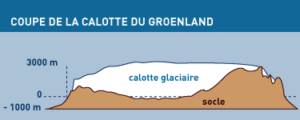
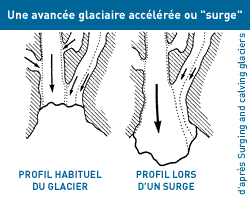
HOW WERE THE POLAR ICE CAPS FORMED ?
Scientists have studied the chemical composition of the polar ice and have deduced that these enormous ice caps were built up over thousands of years. But for that to have happened, there had to be much heavier snowfalls than there are today in these icy deserts. Yet the cold air over the poles is dry and should not have generated such heavy snowfalls.
During the most recent ice ages in the Northern Hemisphere, the temperature of the ocean was 1 or 2 degrees higher than it is today. That differential was enough for the thermal gradient between the “warm” ocean and the very cold landmass to cause snowstorms to develop.
The Greenland ice cap was formed about 3 million years ago when the climate got colder (since then, there have been more than 25 cold periods). Under the weight of the ice cap, the continent sank down more than a kilometre into the Earth’s mantle, forming a wide basin.
ICE CAPS CAN WEIGH CONTINENTS DOWN
During the Quaternary period, thick heavy ice caps covered much of northern Europe and North America. The weight of the ice caps bore the continents down and they sank lower into the fluid mantle of the Earth, rather like a ship when it is being loaded. Today, freed of their load, these continents are very slowly rising up again.
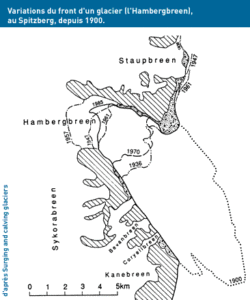
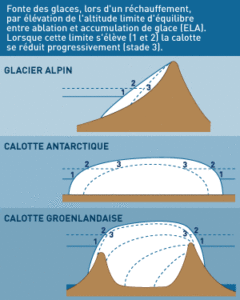
ICEBERGS ARE FORMED WHEN GLACIERS CALVE
When the slowly moving ice nears the coast, it is channelled by coastal glaciers and its speed increases, sometimes reaching several metres per day. Once the tongue of ice, which is lighter than water, reaches the sea it lifts off its rocky bed and starts to float. Currents, tides and wind combine to break up this floating glacier, and large chunks fall off with a noise like thunder. These are what we know as icebergs, or “mountains of ice”.
MONITORING THE POLAR GLACIERS
In recent years oil companies have been exploring offshore zones in the Barents Sea with a view to producing the oil and gas resources there. This has led to studies focusing on calving by the Svalbard glaciers, because a number of these produce icebergs that are a danger to the offshore oil facilities, particularly when the glaciers speed up, or surge, thus calving even more.
Very little is known about this phenomenon of intensive calving and the periods when it occurs, which are different for each glacier. This lack of knowledge is a big handicap for efforts to understand the present state of the ice caps and to be able to predict how they will react to any change in climate.
Among the 90 glaciers calving to icebergs at sea that have been studied, 55 surges have been recorded in the last 100-150 years, but no pattern has yet been identified. The only progress made has been that we now have a list of potential “iceberg calvers”.
During a glacier surge, which is always sudden, large areas of crevasses appear, the front of the glacier bulges and the moraines sag and the volume of ice sticking out into the sea increases significantly. As a result, an enormous amount of ice from higher on the glacier is pushed downhill, causing the front to advance much more rapidly (the glacier’s speed can reach 100 metres per day as the underside is lubricated by melt-water due to friction). Under normal conditions, a glacier is in equilibrium: the ice removed at the bottom is balanced by ice being formed at the top from snowfalls. But surges tend to unbalance the system and markedly diminish the overall amount of ice in the glacier.
ICEBERGS: ICE MOUNTAINS DRIFTING
In addition to the pack ice, the Arctic Ocean carries icebergs.
The origin of these huge ice cubes can be recognized by their shape. The icebergs of narrow and thick glaciers like those of the islands or Greenland are massive and high, whereas those coming from the flat of Ellesmer Land are tabular. These flat icebergs, which can reach several km2, are also used as drifting stations by scientists.
They are sometimes caught in the pack ice and drift towards the North Atlantic. Bursting with wind and waves, 400 icebergs reach, on average, the 48th parallel, off Newfoundland.
To avoid accidents, in winter, the sea routes are pushed back several hundred kilometers to the south. Everyone knows the dramatic story of the Titanic …


